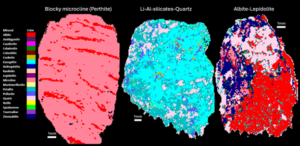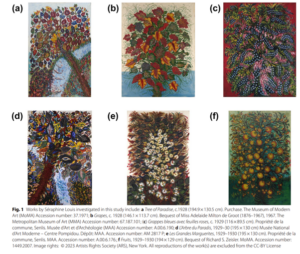
A Bright Future Ahead
Portable Spectral Services Announces Exciting Management Transition
Fluorite is a common mineral composed of calcium and fluorine (CaF2), it is known for its unique properties and characteristics. Fluorite is used in many capacities, ranging from steel production and jewellery to ceramics and optical lenses. Detecting fluorine through XRF technology has previously been difficult due to the open-beam nature of portable-XRF instruments. A pXRF can typically detect elements ranging from Mg – U simultaneously, fluorescent X-rays of elements lighter than magnesium struggle to escape from a sample and/or penetrate the air to reach the detector without being reabsorbed.
Micro-XRF technology however, as a closed-beam instrument with the ability to put samples into a vacuum, has a greater detection limit of lighter elements. Typically, the Bruker M4 TORNADO PLUS has a limit of detection of sodium at 66 ppm. With certain scanning parameters, a fluorine peak can be detected, and in some cases depending on the type of sample, a carbon peak can be visible on the spectrum. Here at Portable Spectral Services, a fluorite sample was scanned in order to extract elemental maps from the data and also to process the sample using automated mineralogy through AMICS (automated mineral identification and characterization system).
As seen in figure 1, one of the unique characteristics of fluorite is its colour. The colour of a fluorite specimen is determined by the presence of various elements in the crystal structure, it can be found in a wide range of colours including purple, blue, green, yellow, and colourless. Figure 2 showcases a rare rainbow fluorite.
Fluorite has many applications, one of these being its historical propensity to be used as a flux (a material to remove impurities such as sulphur and phosphorus) in the production of steel. Fluorite is particularly effective at this task because it has a high melting point and can withstand high temperatures used in steel production. It also has a unique chemical composition that allows it to react with the impurities in the steel and remove them from the final product.
As a flux, fluorite can also be used in the production of glass and ceramics, as it helps to reduce viscosity, making the material easier to work with. Fluorite is likewise used in aluminium production, it is added to the aluminium as it is being smelted, where it reacts with oxygen to form Al-oxide, which is then removed as a slag. This process helps to purify the aluminium and improve its strength and durability.
The fluorite-bearing sample was scanned under a vacuum of 2mbar, with a pixel size of 40µm and a dwell time of 30ms per pixel. The spectra for an area within fluorite is displayed below (figure 3a), showcasing fluorine and calcium spectral peaks. This spectrum translates into a fluorine map shown in figure 3b.
In addition to its use in steel and aluminium production, fluorite is also used in the manufacturing of optical lenses, enamels, and ceramics. One of the main reasons why fluorite is used in optics is because of its high refractive index, which is a measure of how much a material bends light. Fluorite has one of the highest refractive indices of any naturally occurring mineral, which makes it ideal for use in lenses and prisms. The high refractive index of fluorite allows it to focus light more effectively than other materials, resulting in sharper and clearer images.
Fluorite is also known for its low dispersion, which is a measure of how much a material spreads out different colours of light. This makes fluorite particularly useful in telescopes as low dispersion materials keep colours purer and more separate, thus reducing chromatic aberration, a common problem in lenses.
Some other uses of fluorite include examples such as in jewellery (as a decorative stone), electron microscopes, hydrofluoric acid, optical fibres, and for water fluoridation – where it is processed and added to a water supply in the form of fluoride compounds to help prevent tooth decay.
In the sample scanned at Portable Spectral Services, it is unlikely that the fluorite present will be processed to aid in preventing someone’s tooth from decaying, but the results from micro-XRF scanning can be useful to a geologist studying the textures, geochemistry, and paragenesis of a sample. One of the great benefits of micro-XRF technology is the ability to produce crisp elemental overlays and heatmaps to assist in this. The associated elements around the fluorite can provide a key insight into the deposition system and potential for mineralisation at this site. Figure 4 displays some examples of elemental overlays and heatmaps.
The next stage to interpret this qualitative data is to process the sample using AMICS. Stay posted for Part 2 where the unique mineralogy of this sample will be investigated.
If you are interested in having your own sample analysed by micro-XRF, contact Portable Spectral Services at [email protected].
For more information on micro-XRF spectroscopy visit www.microxrf.com.au/

Portable Spectral Services Announces Exciting Management Transition

Our tool introduces uXRF (micro-X-ray fluorescence) scanning technology to RC chip analysis, enabling rapid, non-destructive, and quantitative analysis of major, minor, and trace mineral phases.

Automated micro-X-ray fluorescence (micro XRF) technology emerges as a powerful tool to rapidly and accurately capture the mineralogy of rock chip, RC and AC samples.

Findings of an ongoing regional evaluation study over concealed Proterozoic lithologies known to host magmatic nickel sulphides with potential to host other base-metal, gold and rare earth elements (“REE”) systems within the Fraser Range, Western Australia.

Findings of an ongoing regional evaluation study over concealed Proterozoic lithologies known to host magmatic nickel sulphides with potential to host other base-metal, gold and rare earth elements (“REE”) systems within the Fraser Range, Western Australia.

Findings of an ongoing regional evaluation study over concealed Proterozoic lithologies known to host magmatic nickel sulphides with potential to host other base-metal, gold and rare earth elements (“REE”) systems within the Fraser Range, Western Australia.